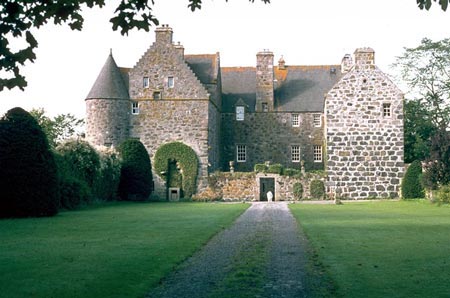
The lands of Barra were once a possession of the Comyn family
prior to the Wars of Independence, whereby they passed to the Family of King.
Barra Castle, or its predecessor was in 1247, and for more than two centuries
after, the seat of the Kings (later of Dudwick in Ellon), who along with the
Forbes Family, were long at feud with the Seton Family of Meldrum and the House
of Gordon. The Kings of Barra were long at feud with the Seton's
of Meldrum, which feud might have been expected to come to a close
towards the end of the 16th century when James King sold Barra to
the Seton's. But no; as late as 1615, Elizabeth Seton
pursued at law James King "sumtyme of Barra' and others for being
art and part in the slaughter of her father, Alexander, fiar of
Meldrum, 'with schottis of hagbuttis and muscattis, commited upon
the landis of Barra...' (the Braes of Bourtie).
Nevertheless, Barra passed by purchase from the Kings of Barra to
the Setonís of Meldrum in the 16th century.
William Seton, 5th of
Meldrum,
married
as his second wife,
Margaret Innes of Leuchars and had his 4th son George
Seton,
Chancellor of St. Macharís Cathedral in Aberdeen.
It was George Seton who enlarged the Castle and added the conical
towers. His emblems of three entwined crescents, over-top of the
windows, can been outside the Castle still to this day, mark his
work which was completed in two stages: 1st in 1614 and 2nd in
1618. Although Barra is Assuredly one of the most attractive
of the lesser castles of Aberdeenshire, it was never fully
completed to George Seton's original plan.
In design Barra Castle is an intricate and singular variation of
the L plan type, the main block lying north/south with a circular tower at the
south west. At the south east a D plan tower. An 18th century addition runs
eastward from the north end of the main block forming a square court closed on
the east side by a wall containing the entrance. The basement of the main block
is vaulted. In its present form it is chiefly the work of George Seton who was
granted the estates in 1598. He
maintained it until 1630 when he sold it to James Reid, (his
grandson was created a baronet in 1703), and who's family kept it
until 1753, when it was sold to the Ramsay family, who added the
north-east extension before passing to the Forbes-Irvine family of
Drum.